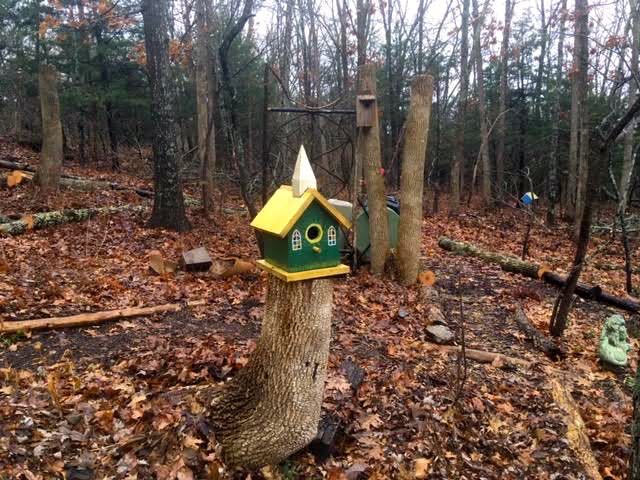Reuse Cut Down Trees
/Reuse Cut Down Trees
I don’t mind leaving dead trees in my wildlife garden for woodpeckers and other creatures but when the trees might fall into my house I have to give that a second thought. Fall of 2018, when 5 more ash trees were identified as having emerald ash borer larvae in their bark, I decided not to wait the 3-4 years before the trees were dead and had them professionally cut down.
Dennis King of King Out On a Limb Tree Trimming Service cutting down one of my five dying ash trees. (Photo by Charlotte Ekker Wiggins)
Usually tree trimmers will haul off the trees but I kept them on site to reuse. The cut trunks are now being used as retaining walls to terrace my new hillside garden beds. The cut down trees help to hold leaves, mulch and soil from getting washed down hill.
Cut down ash trees now form new hillside terracing. (Photo by Charlotte Ekker Wiggins)
The tree stumps themselves were not cut to the ground, they were specifically left so that I can use them later. I asked that they leave the tree trunks so that I can then cut them lower as necessary.
The recently-cut down ash trees are in the back. The one with the birdhouse had to be cut down several years ago and is now a birdhouse base.
This church birdhouse sits on top of a cut down ash tree trunk stub. (Photo by Charlotte Ekker Wiggins)
The smaller ash tree limbs are now refreshing wildlife refuge piles I have along my property line and the nearby woods. As a certified wildlife garden, providing safety through cover is important to some wildlife species especially in winter.
Smaller ash tree branches refresh a wildlife pile. (Photo by Charlotte Ekker Wiggins)
The emerald ash borer-damaged trees were marked in summer with pink plastic so that I knew what trees needed to be removed. Actually it was more for the tree service although they didn’t have any trouble locating the trees on their first visit. Woodpeckers had removed pieces of tree bark as they went after the emerald ash borer larvae under the tree bark.
Pink plastic marked the ash trees to be cut down. (Photo by Charlotte Ekker Wiggins)
Although most people will wait until spring and summer to get them cut, I did it late fall on a warm day since the tree cutting company was available. Usually tree-trimmers are very busy during spring and summer and may need several weeks and months advance notice.
Here’s another tree stump from a few years ago that now serves as a stand.
This metal bee sculpture now sits on top of a cut down ash tree. (Photo by Charlotte Ekker Wiggins)
Although I was not happy to lose the ash trees, I was glad to recycle them on my hillside garden instead of having them hauled off to the recycling center, where I go to pick up my mulch. This way the trees continue to retain water to help keep flower bed soil moist as well!
Charlotte

















